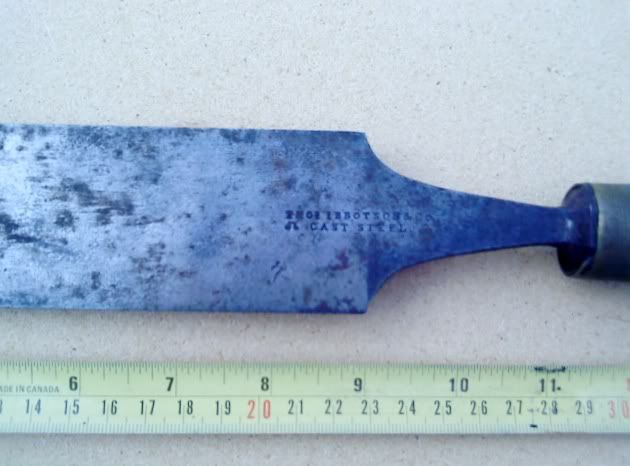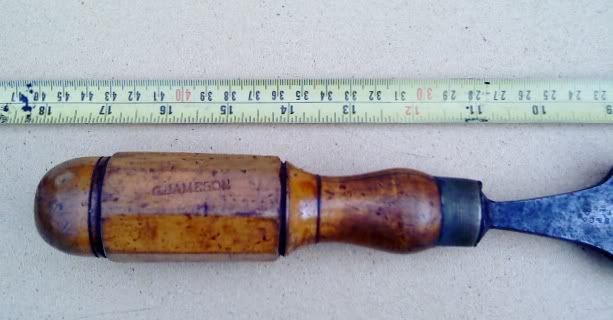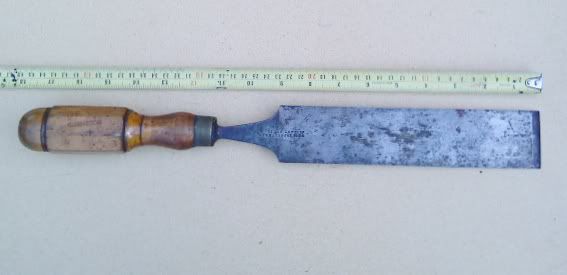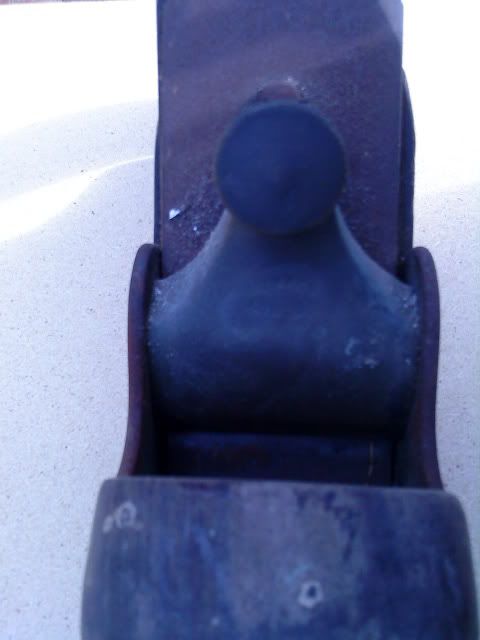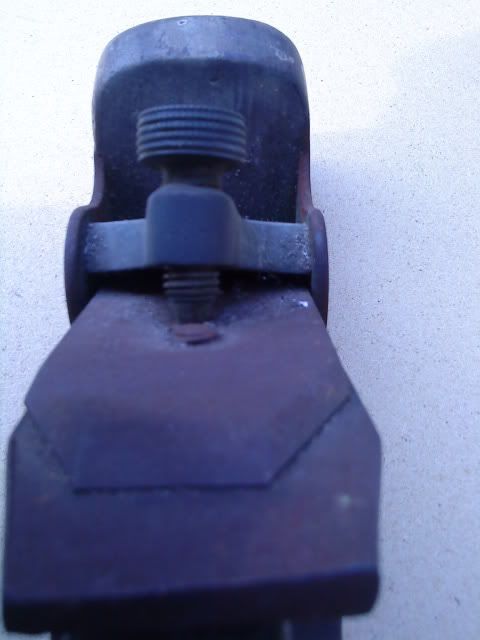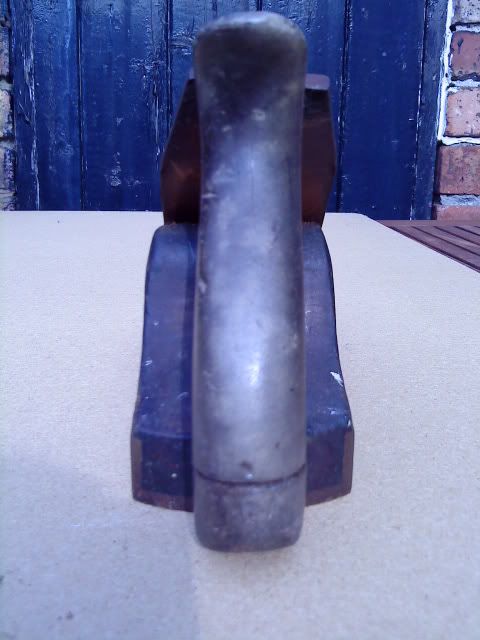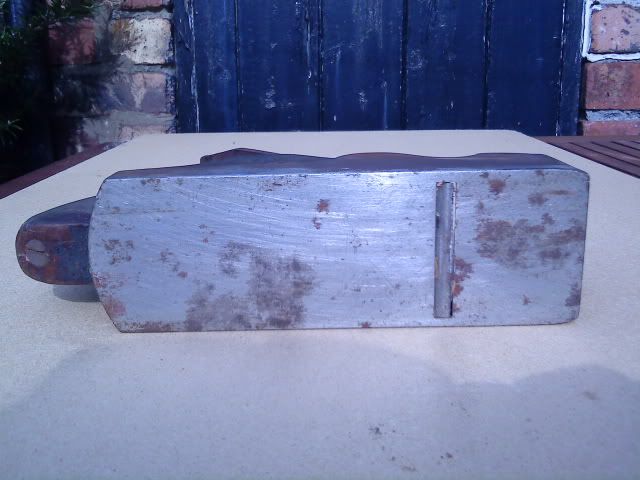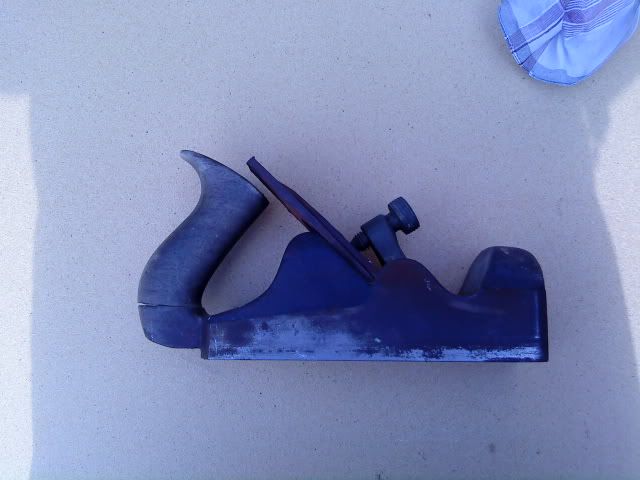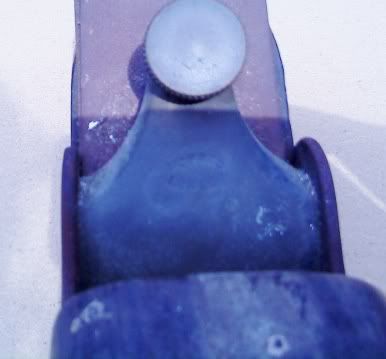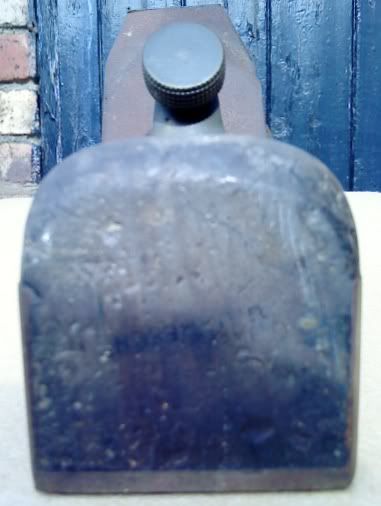You are using an out of date browser. It may not display this or other websites correctly.
You should upgrade or use an alternative browser.
You should upgrade or use an alternative browser.
I inherited a shed
- Thread starter jessup
- Start date

Help Support UKworkshop.co.uk:
This site may earn a commission from merchant affiliate
links, including eBay, Amazon, and others.
Cheshirechappie
Established Member
Thomas Ibbotson and Co. (20, Paternoster Row, Sheffield) were in business as a joiner's toolmaker from 1833 'till 1909, according to W.L.Goodman's 'British Planemakers from 1700'.
If you see 'steel' stamped on a plane iron or chisel, it's likely to be half of the mark 'Cast Steel', which was the material that made Sheffield's edge tool makers and cutlers famous. It was one of the best grades of steel available for edge-tool making from about 1800 until the development of alloy steels in the very late 19th century and early 20th. It was still made until just after the second world war. Many people seek out old tools so stamped, because they reckon 'cast steel' is the equal or better of anything produced since.
If it's got a 9" blade, it sounds like a patternmaker's paring chisel. Many joiners and cabinetmakers owned a few. They are highly regarded today. DON'T use it for opening paint tins!
If you see 'steel' stamped on a plane iron or chisel, it's likely to be half of the mark 'Cast Steel', which was the material that made Sheffield's edge tool makers and cutlers famous. It was one of the best grades of steel available for edge-tool making from about 1800 until the development of alloy steels in the very late 19th century and early 20th. It was still made until just after the second world war. Many people seek out old tools so stamped, because they reckon 'cast steel' is the equal or better of anything produced since.
If it's got a 9" blade, it sounds like a patternmaker's paring chisel. Many joiners and cabinetmakers owned a few. They are highly regarded today. DON'T use it for opening paint tins!
For the love of all that's holy. A terrible week followed by my computer running into a full scan.... just when I have tool pics to share.
That thunk sound? It's my head hitting the table.
I'll be back.... drags off in search of hard liquor.
That thunk sound? It's my head hitting the table.
I'll be back.... drags off in search of hard liquor.
jimi43
Established Member
Hi Jessup...
Beautiful Thomas Ibbotson chisel there my friend...I love that old steel.
The old Norris is a bit beaten up I'm afraid but will still be of interest to quite a few people...restorers, people in need of the missing part or two...
As you say...the pictures are not really clear enough to see what is going on but the handle needs proper restoration (split at base is quite common)....the iron needs sorting out...no idea what's going on there...and it needs a little tidy up on the steel front...
I wouldn't worry too much about surface rust...this is how my old Tyzack Norris arrived...
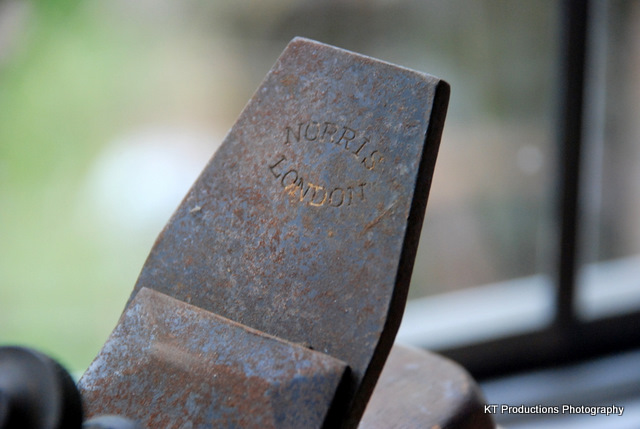
...at first glance in dreadful nick...but after proper treatment....
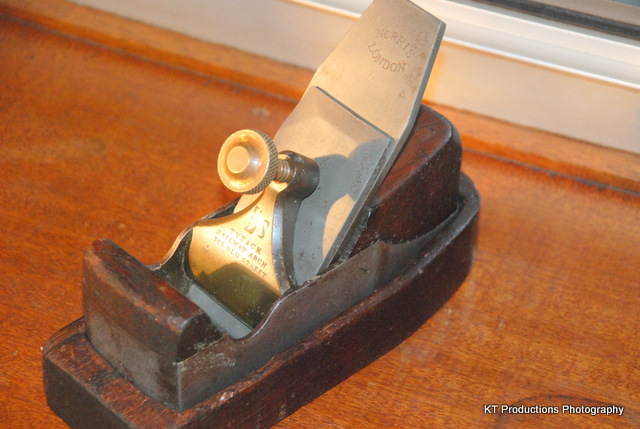
...it came out fine...the steel is really good quality!
I would suggest you get some decent pictures from every angle...take the iron out and cap iron off and photograph them apart...and then stick it up on FleaBay and see what it makes.
I actually prefer other makes like Spiers and Slater....mostly because I can't afford the collector prices that Norris planes command....mostly driven up by US buyers....but the irons that they made are second to none...really beautiful pieces of steel and cut like a razor.
Beautiful Thomas Ibbotson chisel there my friend...I love that old steel.
The old Norris is a bit beaten up I'm afraid but will still be of interest to quite a few people...restorers, people in need of the missing part or two...
As you say...the pictures are not really clear enough to see what is going on but the handle needs proper restoration (split at base is quite common)....the iron needs sorting out...no idea what's going on there...and it needs a little tidy up on the steel front...
I wouldn't worry too much about surface rust...this is how my old Tyzack Norris arrived...

...at first glance in dreadful nick...but after proper treatment....

...it came out fine...the steel is really good quality!
I would suggest you get some decent pictures from every angle...take the iron out and cap iron off and photograph them apart...and then stick it up on FleaBay and see what it makes.
I actually prefer other makes like Spiers and Slater....mostly because I can't afford the collector prices that Norris planes command....mostly driven up by US buyers....but the irons that they made are second to none...really beautiful pieces of steel and cut like a razor.
jimi43
Yes, it was so bright I could hardly see where the thing was! Added to that this lil camera makes everything blue. I think I may just whack it on fleabay. Truth is I've got so much stuff to go thru...I've got to start somewhere.
The cap iron is the piece on top of the cutting iron? There is no mark on the iron. I have rubbed with a very dry cotton cloth and there is no hint of anything.
Thanks for the help.
J
Yes, it was so bright I could hardly see where the thing was! Added to that this lil camera makes everything blue. I think I may just whack it on fleabay. Truth is I've got so much stuff to go thru...I've got to start somewhere.
The cap iron is the piece on top of the cutting iron? There is no mark on the iron. I have rubbed with a very dry cotton cloth and there is no hint of anything.
Thanks for the help.
J
Cheshirechappie
Established Member
Hi Jessup,
I can't tell you anything about the Norris plane that Jimi hasn't already said far better than I could, but I can offer a thought or two on the Ibbotson chisel.
It is indeed a patternmaker's paring chisel. Chisels are usually 'sized' by the width of the cutting edge, and that one looks to be a 2". The handle is 'London Pattern', gorgeous, and original. Hard to tell from the photo, but I suspect it's boxwood - often used in top-quality chisel handles. It's thin-bladed to make it lighter in use for paring - shaving bits off to make close fits between components, or to get an exact size. This isn't a chisel that would ever be used with a mallet, only by hand. If you look at the end of the handle, it probably has no mallet damage. The blade is probably tapered slightly both in width and thickness, wider at the cutting edge than the tang end, and thicker at the tang end than at the cutting edge. Those tapers were forged in by eye under a spring hammer - just by the hammerman's skill. That style of blade was common in the 18th century, but fell out of favour in the late 19th, so that may mean it was made in the early or middle 1800's rather than late 1800's.
Patternmakers were among the most highly regarded of the woodworking trades. Patterns are the first stage in making metal castings - a wooden model. The pattern was embedded in sand in a wooden or metal box, then the box/sand/pattern lump inverted, and the pattern drawn out. Molten metal was then poured into the resulting hole, and when it had cooled, the sand knocked off to leave the casting. Complicated castings involved intricate patterns with many bits fitting together, cores that could be installed in the mould to make hollow castings, and so on. Because metals contract as they cool, the pattern had to be made slightly larger than the finished casting was required, and because the pattern had to be drawn from the sand, it had to be made slightly tapered. So patternmakers had a lot to get right - hence their need for tools that could adjust bits of wood to very close measurements!
I know this because I inherited a very similar chisel (mine's a 1 1/2", by I&H Sorby) from my grandpa, and I know he got it very secondhand. The handle on mine was beech, and rotten, so I replaced it in rosewood, using a shape very similar to yours. It's one of my favourite tools, and I won't part with it for anything. But yours is better than mine - original handle, lovely patina, respected maker - the collectors would fall over themselves for it.
Should you ever take up cabinetmaking (other than desk modification!) you'll find that this chisel will take a wondeful cutting edge. Keep it safe for the finest work - it's a VERY fine tool.
I can't tell you anything about the Norris plane that Jimi hasn't already said far better than I could, but I can offer a thought or two on the Ibbotson chisel.
It is indeed a patternmaker's paring chisel. Chisels are usually 'sized' by the width of the cutting edge, and that one looks to be a 2". The handle is 'London Pattern', gorgeous, and original. Hard to tell from the photo, but I suspect it's boxwood - often used in top-quality chisel handles. It's thin-bladed to make it lighter in use for paring - shaving bits off to make close fits between components, or to get an exact size. This isn't a chisel that would ever be used with a mallet, only by hand. If you look at the end of the handle, it probably has no mallet damage. The blade is probably tapered slightly both in width and thickness, wider at the cutting edge than the tang end, and thicker at the tang end than at the cutting edge. Those tapers were forged in by eye under a spring hammer - just by the hammerman's skill. That style of blade was common in the 18th century, but fell out of favour in the late 19th, so that may mean it was made in the early or middle 1800's rather than late 1800's.
Patternmakers were among the most highly regarded of the woodworking trades. Patterns are the first stage in making metal castings - a wooden model. The pattern was embedded in sand in a wooden or metal box, then the box/sand/pattern lump inverted, and the pattern drawn out. Molten metal was then poured into the resulting hole, and when it had cooled, the sand knocked off to leave the casting. Complicated castings involved intricate patterns with many bits fitting together, cores that could be installed in the mould to make hollow castings, and so on. Because metals contract as they cool, the pattern had to be made slightly larger than the finished casting was required, and because the pattern had to be drawn from the sand, it had to be made slightly tapered. So patternmakers had a lot to get right - hence their need for tools that could adjust bits of wood to very close measurements!
I know this because I inherited a very similar chisel (mine's a 1 1/2", by I&H Sorby) from my grandpa, and I know he got it very secondhand. The handle on mine was beech, and rotten, so I replaced it in rosewood, using a shape very similar to yours. It's one of my favourite tools, and I won't part with it for anything. But yours is better than mine - original handle, lovely patina, respected maker - the collectors would fall over themselves for it.
Should you ever take up cabinetmaking (other than desk modification!) you'll find that this chisel will take a wondeful cutting edge. Keep it safe for the finest work - it's a VERY fine tool.
Cheshirechappie
Thanks for the info about the chisel. It is a lovely thing to just hold. I'd found something about Ibbotson on line and saw it was taken over around 1905.
It is 2ins. I'll have a closer look at it re tapering.
Sure all cabinet making starts with "what the...? if I just.... Yes... it does still work" At least mine would.
I've printed off your answer so I can look and learn.
Thanks J
Thanks for the info about the chisel. It is a lovely thing to just hold. I'd found something about Ibbotson on line and saw it was taken over around 1905.
It is 2ins. I'll have a closer look at it re tapering.
Sure all cabinet making starts with "what the...? if I just.... Yes... it does still work" At least mine would.
I've printed off your answer so I can look and learn.
Thanks J
jimi43
Established Member
jessup":3a2bfe8m said:jimi43
Yes, it was so bright I could hardly see where the thing was! Added to that this lil camera makes everything blue. I think I may just whack it on fleabay. Truth is I've got so much stuff to go thru...I've got to start somewhere.
The cap iron is the piece on top of the cutting iron? There is no mark on the iron. I have rubbed with a very dry cotton cloth and there is no hint of anything.
Thanks for the help.
J
AH! It's sunlight....a shadow across the iron! DOH! I thought it was something quite different...now I see it!
Cheers
Jim
Similar threads
- Replies
- 3
- Views
- 184




